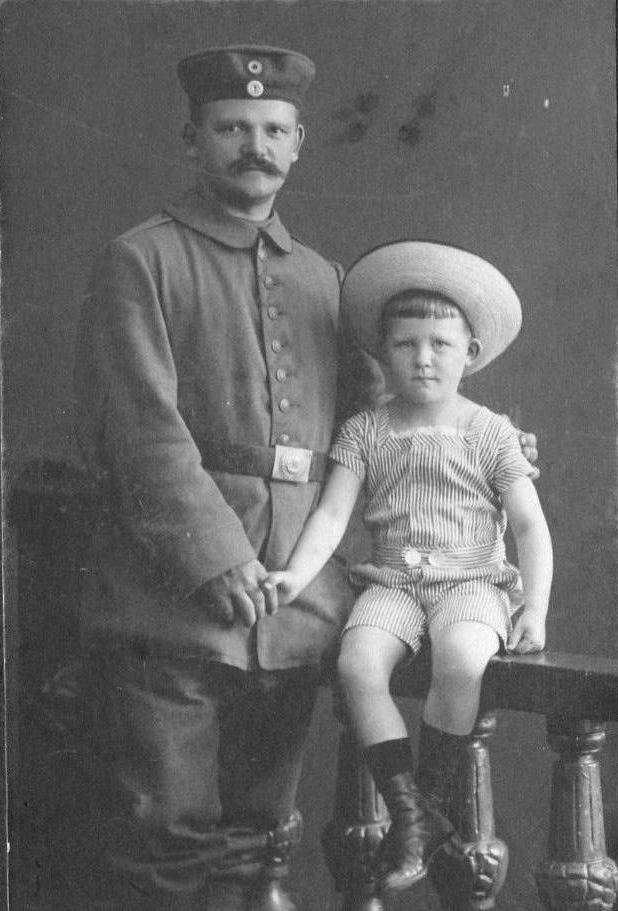
World War I: German Conscript Army

Figure 1.--This German cabinet card portrait show a midle-age man that has bee called up for military service. The portrait is undated, but almost certainly was taken in World war. The father probbly had it taken just before reporting to hus unit, erhaps at the onst of the War (August 1914). It obviuosly was taken during the summer. The studio was in Neheim, Germany. The image is a haunting record of what war meant for families. Men were the family breadwinners. If killed or badly wounded it would mean that the boy and his mother would descend into poverty.
T
|
|
Key to German military power was a massive conscript army and a high state of military readiness. Other European countris (except Britain) also had conscription srvice, but not the same level of readiness. United Germany had both the industrial capacity and population which combined made it the most powerful country in Europe. The Imperial German Army had the most professional standing army and a system for rapidly mobilized well-trained reserves. Which is just what happened when Germany decided to launch World War I. [Fosten and Marrion] The German Army before the War drafted men at 20 yearsof age. They then served for 2-3 years of peacetime training in the active army. While all German males had an obligation to serve, the individual's financial circumstances meant that only about half of each annual cohart was actually conscripted. After their 2-3 years of training training, men were released back into civilian life. They were subject to ld be called back into the Army in time of emergency until they reached age 45 years. As they aged, German men men passed through various reserve readiness categories. First, the younger men who had just recently completed their active military training constituted the first-line Landsturm (reserve) for 5 years. They were subject to be called up in the event of national crisis. Second the men were placed second-line Landwehr fot 10 years. Third was the third-line Landsturm with the oldest group of reservists, men about 30-45 years of age. They were to be ysed in rear areas in any major war. The Herman conscription system had two advantages. short-service conscript system offered two major advantages. First, it created a substantial pool of well-trained men that could be rapidly mobilized to expanding the standing professional army in any emergency. This enable the German Army in just 12 days to expand from 0.8 million to 3.5 million men (August 1914). Second, it provided an organisational srructure capable of deploying nearly the country's entire manpower for war. As the War progressed many men that were exemplted from conscription in peacetime were concripted as the war progressed. The Germans also began concripting younger coharts. Over 80 percent of military agevmen were conscripted, similar to conscription levels in France.
Sources
Fosten, Donald and Robert Marrion. World War 1: The German Army 1914–18 (Men at Arms 80, 1978), 48p.
CIH -- WW I

Navigate the Boys' Historical Clothing Web Site:
[Return to Main German conscription page]
[Return to Main World War I people page]
[About Us]
[Aftermath]
[Alliances]
[Animals]
[Armistace]
[Biographies]
[Causes]
[Campaigns]
[Casualties]
[Children]
[Countries]
[Declaration of war]
[Deciding factors]
-------[Diplomacy]
[Economics]
-------[Geo-political crisis]
[Home front]
[Intelligence]
[Military forces]
[Neutrality]
[Pacifism]
[People]
[Peace treaties]
[Propaganda]
[POWs]
[Russian Revolution]
[Terrorism]
[Trench warfare]
------[Technology]
[Weaponry]
[Bibliographies]
[Contributions]
[FAQs]
[Images]
[Links]
[Registration]
[Tools]
[Return to Main World War I page]
[Return to Main war essay page]
[Return to CIH Home page]
Created: 9:22 PM 10/17/2017
Last updated: 9:22 PM 10/17/2017



